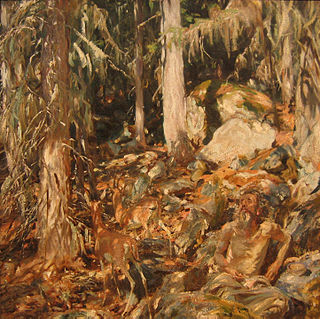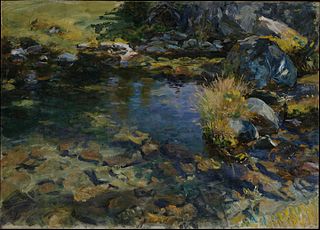
John Singer Sargent was an American expatriate artist, considered the "leading portrait painter of his generation" for his evocations of Edwardian-era luxury. He created roughly 900 oil paintings and more than 2,000 watercolors, as well as countless sketches and charcoal drawings. His oeuvre documents worldwide travel, from Venice to the Tyrol, Corfu, Spain, the Middle East, Montana, Maine, and Florida.

Events from the year 1911 in art.

Carrara is a city and comune in Tuscany, in central Italy, of the province of Massa and Carrara, and notable for the white or blue-grey marble quarried there. It is on the Carrione River, some 100 kilometres (62 mi) west-northwest of Florence. Its motto is Fortitudo mea in rota.

Carrara marble, Luna marble to the Romans, is a type of white or blue-grey marble popular for use in sculpture and building decor. It has been quarried since Roman times in the mountains just outside the city of Carrara in the province of Massa and Carrara in the Lunigiana, the northernmost tip of modern-day Tuscany, Italy.

Madame X or Portrait of Madame X is a portrait painting by John Singer Sargent of a young socialite, Virginie Amélie Avegno Gautreau, wife of the French banker Pierre Gautreau. Madame X was painted not as a commission, but at the request of Sargent. It is a study in opposition. Sargent shows a woman posing in a black satin dress with jeweled straps, a dress that reveals and hides at the same time. The portrait is characterized by the pale flesh tone of the subject contrasted against a dark-colored dress and background.

Gassed is a very large oil painting completed in March 1919 by John Singer Sargent. It depicts the aftermath of a mustard gas attack during the First World War, with a line of wounded soldiers walking towards a dressing station. Sargent was commissioned by the British War Memorials Committee to document the war and visited the Western Front in July 1918 spending time with the Guards Division near Arras, and then with the American Expeditionary Forces near Ypres. The painting was finished in March 1919 and voted picture of the year by the Royal Academy of Arts in 1919. It is now held by the Imperial War Museum. It visited the US in 1999 for a series of retrospective exhibitions, and then from 2016 to 2018 for exhibitions commemorating the centenary of the First World War.
The Cloak of Conscience and Tolerance is a sculpture by Anna Chromý carved from a single block of white marble excavated from the Michelangelo Quarry in Carrara, Italy, where Michelangelo sourced the marble for his iconic David. Anna Chromy's creation represents her largest work of art since Chromy turned to sculpture from surrealist oil paintings in 1992. As a result of her work on Cloak, Chromy was the first woman to be awarded the Premio Michelangelo, the annual award for sculpture, in 2008.

The Misses Vickers is an oil painting by John Singer Sargent. The painting depicts three young ladies, from the Vickers family, in their estate in Bolsover Hill, Sheffield, England.

Carnation, Lily, Lily, Rose is an oil-on-canvas painting made by the American painter John Singer Sargent in 1885–86.

Emil Fuchs was an Austrian–American sculptor, medallist, painter, and author who worked in Vienna, London and New York. He painted portraits of Queen Victoria and Edward VII and was fashionable among London high society in the early 20th century.

Lady Agnew of Lochnaw is an oil on canvas portrait painting of Gertrude Agnew, the wife of Sir Andrew Agnew, 9th Baronet. The painting was commissioned in 1892 and completed the same year by the American portrait artist John Singer Sargent. It measures 127 × 101 cm (50.0 × 39.8 in) and is owned by the Scottish National Gallery in Edinburgh, Scotland. The museum acquired it through the Cowan Smith Bequest Fund in 1925.

William M. Chase, N. A. is a 1902 painting by John Singer Sargent. It is part of the collection of the Metropolitan Museum of Art in New York.

The Wyndham Sisters: Lady Elcho, Mrs. Adeane, and Mrs. Tennant is an 1899 painting by John Singer Sargent. It is part of the collection of the Metropolitan Museum of Art. The painting was hailed by the critics and dubbed “The Three Graces” by the Prince of Wales.

Egyptians Raising Water from the Nile is an 1890–1891 painting by John Singer Sargent. It is part of the collection of the Metropolitan Museum of Art, New York City, United States.

Mrs. Hugh Hammersley is an 1892 painting by John Singer Sargent. It is part of the collection of the Metropolitan Museum of Art.

The Hermit (Il solitario) is a 1908 painting by John Singer Sargent. It is part of the collection of the Metropolitan Museum of Art.

Alpine Pool is a 1907 painting by John Singer Sargent. It is part of the collection of the Metropolitan Museum of Art.

Padre Sebastiano is a 1904–1906 painting by John Singer Sargent. It is part of the collection of the Metropolitan Museum of Art.

Tyrolese Interior is a 1915 painting by John Singer Sargent. It is part of the collection of the Metropolitan Museum of Art.

Tommies Bathing is a 1918 watercolor painting by John Singer Sargent. It is in the collection of the Metropolitan Museum of Art.



















